Ultrasonic Structural Health Monitoring Using Fiber Bragg Grating
Abstract
1. Introduction
2. Ultrasonic Fiber Bragg Grating Sensor
2.1. Fiber Bragg Grating
2.2. The Principle of Ultrasonic Detection
2.3. Special Fiber Bragg Gratings
3. Demodulation Techniques
3.1. Comparison of Demodulation
3.2. Broadband Light Source
3.3. Laser Light Source
3.4. Erbium-Doped Fiber Laser
3.5. Modulated Laser
4. The Ultrasonic Wave from Structure to Fiber
4.1. FBG under the Influence of a Lamb Wave
4.2. Ultrasonic Wave Propagation along the Fiber
4.3. Mechanically Aided Sensor
5. FBG in Ultrasonic Structural Health Monitoring
5.1. Comparison of Ultrasonic SHM Techniques
5.2. Impact Detection
5.3. Acousto-Ultrasonic Detection
5.4. Acoustic Emission Detection
6. Future Trends
7. Conclusions
Funding
Conflicts of Interest
References
- Bryan, H. Fatigue in Composites: Science and Technology of the Fatigue Response of Fibre-Reinforced Plastics; Woodhead Publishing: Cambridge, UK, 2003. [Google Scholar]
- Peter, B.; Soutis, C.; Hodzic, A. Structural Integrity and Durability of Advanced Composites: Innovative Modelling Methods and Intelligent Design; Woodhead Publishing: Cambridge, UK, 2015. [Google Scholar]
- Tressler, J.F.; Alkoy, S.; Newnham, R.E. Piezoelectric sensors and sensor materials. J. Electroceram. 1998, 2, 257–272. [Google Scholar] [CrossRef]
- Giurgiutiu, V. Structural Health Monitoring with Piezoelectric Wafer Active Sensors (Second Edition). 2007. Available online: https://www.sciencedirect.com (accessed on 8 February 2018).
- Sodano, H.A. Macro-Fiber Composites for Sensing, Actuation and Power Generation. Master’s Thesis, Virginia Polytechnic Institute and State University, Blacksburg, Virginia, USA, 2003. [Google Scholar]
- Eaton, M.; Pullin, R.; Holford, K.; Evans, S.; Featherston, C.; Rose, A. Use of macro fibre composite transducers as acoustic emission sensors. Remote Sens. 2009, 1, 68–79. [Google Scholar] [CrossRef]
- Wild, G.; Hinckley, S. Acousto-ultrasonic optical fiber sensors: Overview and state-of-the-art. IEEE Sens. J. 2008, 8, 1184–1193. [Google Scholar] [CrossRef]
- Othonos, A. Fiber Bragg gratings. Rev. Sci. Instrum. 1997, 68, 4309–4341. [Google Scholar] [CrossRef]
- Hill, K.O.; Meltz, G. Fiber Bragg grating technology fundamentals and overview. J. Lightw. Technol. 1997, 15, 1263–1276. [Google Scholar] [CrossRef]
- Fisher, N.E.; Webb, D.J.; Pannell, C.N.; Jackson, D.A.; Gavrilov, L.R.; Hand, J.W.; Zhang, L.; Bennion, I. Ultrasonic hydrophone based on short in-fiber Bragg gratings. Appl. Opt. 1998, 37, 8120–8128. [Google Scholar] [CrossRef] [PubMed]
- Campopiano, S.; Cutolo, A.; Cusano, A.; Giordano, M.; Parente, G.; Lanza, G.; Laudati, A. Underwater acoustic sensors based on fiber Bragg gratings. Sensors 2009, 9, 4446–4454. [Google Scholar] [CrossRef] [PubMed]
- Fomitchov, P.; Krishnaswamy, S. Response of a fiber Bragg grating ultrasonic sensor. Opt. Eng. 2003, 42, 956–964. [Google Scholar] [CrossRef]
- Kersey, A.D.; Davis, M.A.; Patrick, H.J.; LeBlanc, M.; Koo, K.P.; Askin, C.G.; Putnam, M.A.; Friebele, E.J. Fiber grating sensors. J. Lightw. Technol. 1997, 15, 1442–1463. [Google Scholar] [CrossRef]
- Rao, Y.J. Recent progress in applications of in-fibre Bragg grating sensors. Opt. Lasers Eng. 1999, 31, 297–324. [Google Scholar] [CrossRef]
- I-MON interrogation monitors for FBG sensor systems. Available online: https://ibsen.com/wp-content/uploads/Ibsen-Product-Sheets-I-MON-High-Speed.pdf (accessed on 1 October 2018).
- SmartScan FBG interrogator. Available online: https://www.smartfibres.com/files/pdf/SmartScan.pdf (accessed on 1 October 2018).
- Fiber Bragg grating transceivers: FBG-TransceiverTM. Available online: http://www.redondooptics.com/FBGT_060209.pdf (accessed on 1 October 2018).
- Mendoza, E.; Prohaska, J.; Kempen, C.; Esterkin, Y.; Sun, S.; Krishnaswamy, S. Distributed fiber optic acoustic emission sensor (FAESense™) system for condition based maintenance of advanced structures. In Proceedings of the Optical Sensors 2013, Rio Grande, Puerto Rico, USA, 14–17 July 2013. [Google Scholar]
- I*Sense® HS48M product specs. Available online: http://www.ifos.com/wp-content/uploads/2013/03/IFOS-ISense-48M-Data-Sheet-V1-2013.pdf (accessed on 1 October 2018).
- Satori, K.; Ikeda, Y.; Kurosawa, Y.; Hongo, A.; Takeda, N. Development of small-diameter optical fiber sensors for damage detection in composite laminates. In Proceedings of the SPIE’s 7th Annual International Symposium on Smart Structures and Materials, Newport Beach, CA, USA, 6–9 March 2000; Volume 3986, pp. 104–111. [Google Scholar]
- Johnson, I.P.; Webb, D.J.; Kalli, K. Hydrostatic pressure sensing using a polymer optical fibre Bragg gratings. In Proceedings of the Third Asia Pacific Optical Sensors Conference, Sydney, Australia, 31 January–3 February 2012; Volume 8351, p. 835106. [Google Scholar]
- Marques, C.A.F.; Webb, D.J.; Andre, P. Polymer optical fiber sensors in human life safety. Opt. Fiber Technol. 2017, 36, 144–154. [Google Scholar] [CrossRef]
- Erdogan, T. Fiber grating spectra. J. Lightw. Technol. 1997, 15, 1277–1294. [Google Scholar] [CrossRef]
- Yamada, M.; Sakuda, K. Analysis of almost-periodic distributed feedback slab waveguides via a fundamental matrix approach. Appl. Opt. 1987, 26, 3474–3478. [Google Scholar] [CrossRef] [PubMed]
- Betz, D.C.; Thursby, G.; Culshaw, B.; Staszewski, W. Acousto-ultrasonic sensing using fiber Bragg gratings. Smart Mater. Struct. 2003, 12, 122–128. [Google Scholar] [CrossRef]
- Minardo, A.; Cusano, A.; Bernini, R.; Zeni, L.; Giordano, M. Response of fiber Bragg gratings to longitudinal ultrasonic waves. IEEE Trans. Ultrason. Ferroelectr. Freq. Control 2005, 52, 304–312. [Google Scholar] [CrossRef] [PubMed]
- Takeda, N.; Okabe, Y.; Kuwahara, J.; Kojima, S.; Ogisu, T. Development of smart composite structures with small-diameter fiber Bragg grating sensors for damage detection: Quantitative evaluation of delamination length in CFRP laminates using Lamb wave sensing. Compos. Sci. Technol. 2005, 65, 2575–2587. [Google Scholar] [CrossRef]
- Lee, J.R.; Tsuda, H.; Toyama, N. Impact wave and damage detections using a strain-free fiber Bragg grating ultrasonic receiver. NDT&E Int. 2007, 40, 85–93. [Google Scholar]
- Betz, D.C.; Thursby, G.; Culshaw, B.; Staszewski, W.J. Identification of structural damage using multifunctional Bragg grating sensors: I. Theory and implementation. Smart Mater. Struct. 2006, 15, 1305. [Google Scholar] [CrossRef]
- Martinez, C.; Ferdinand, P. Analysis of phase-shifted fiber Bragg gratings written with phase plates. Appl. Opt. 1999, 38, 3223–3228. [Google Scholar] [CrossRef] [PubMed]
- LeBlanc, M.; Kersey, A.D.; Tsai, T. Sub-nanostrain strain measurements using a pi-phase shifted grating. In Proceedings of the 12th International Conference on Optical Fiber Sensors, Williamsburg, VA, USA, 28 October 1997; Volume 16, pp. 28–30. [Google Scholar]
- LeBlanc, M.; Vohra, S.T.; Tsai, T.E.; Friebele, E.J. Transverse load sensing by use of pi-phase-shifted fiber Bragg gratings. Opt. Lett. 1999, 24, 1091–1093. [Google Scholar] [CrossRef] [PubMed]
- Liu, T.; Han, M. Analysis of π-Phase-Shifted Fiber Bragg Gratings for Ultrasonic Detection. IEEE Sens. J. 2012, 12, 2368–2373. [Google Scholar] [CrossRef]
- Rosenthal, A.; Razansky, D.; Ntziachristos, V. High-sensitivity compact ultrasonic detector based on a pi-phase-shifted fiber Bragg grating. Opt. Lett. 2011, 36, 1833–1835. [Google Scholar] [CrossRef] [PubMed]
- Azmi, A.I.; Sen, D.; Sheng, W.; Canning, J.; Peng, G.D. Performance Enhancement of Vibration Sensing Employing Multiple Phase-Shifted Fiber Bragg Grating. J. Lightw. Technol. 2011, 29, 3453–3460. [Google Scholar] [CrossRef]
- Tsuda, H.; Kumakura, K.; Ogihara, S. Ultrasonic sensitivity of strain-insensitive fiber Bragg grating sensors and evaluation of ultrasound-induced strain. Sensors 2010, 10, 11248–11258. [Google Scholar] [CrossRef] [PubMed]
- Hamstad, M.A. A review: Acoustic emission, a tool for composite-materials studies. Exp. Mech. 1986, 26, 7–13. [Google Scholar] [CrossRef]
- Scruby, C. An introduction to acoustic emission. J. Phys. E Sci. Instrum. 1987, 20, 946–953. [Google Scholar] [CrossRef]
- Lobo Ribeiro, A.B.; Ferreira, L.A.; Santos, J.L.; Jackson, D.A. Analysis of the reflective-matched fiber Bragg grating sensing interrogation scheme. Appl. Opt. 1997, 36, 934–939. [Google Scholar] [CrossRef] [PubMed]
- Wu, Q.; Okabe, Y. Novel real-time acousto-ultrasonic sensors using two phase-shifted fiber Bragg gratings. J. Intell. Mater. Syst. Struct. 2014, 25, 640–646. [Google Scholar] [CrossRef]
- Perez, I.; Cui, H.L.; Udd, E. High frequency ultrasonic wave detection using fiber Bragg gratings. In Proceedings of the SPIE’s 7th Annual International Symposium on Smart Structures and Materials, Newport Beach, CA, USA, 6–9 March 2000. [Google Scholar]
- Perez, I.; Cui, H.L.; Udd, E. Acoustic emission detection using fiber Bragg gratings. In Proceedings of the SPIE’s 8th Annual International Symposium on Smart Structures and Materials, Newport Beach, CA, USA, 4–8 March 2001; Volume 4328, pp. 209–215. [Google Scholar]
- Cui, J.; Hu, Y.; Feng, K.; Li, J.; Tan, J. FBG Interrogation Method with High Resolution and Response Speed Based on a Reflective-Matched FBG Scheme. Sensors 2015, 15, 16516–16535. [Google Scholar] [CrossRef] [PubMed]
- Vella, T.; Chadderdon, S.; Selfridge, R.; Schultz, S.; Webb, S.; Park, C.; Peters, K.; Zikry, M. Full-spectrum interrogation of fiber Bragg gratings at 100 kHz for detection of impact loading. Meas. Sci. Technol. 2010, 21, 094009. [Google Scholar] [CrossRef]
- Kirikera, G.R.; Balogun, O.; Krishnaswamy, S. Adaptive fiber Bragg grating sensor network for structural health monitoring: Applications to impact monitoring. Struct. Health Monit. 2011, 10, 5–12. [Google Scholar] [CrossRef]
- Talaverano, L.; Abad, S.; Jarabo, S.; Lopez-Amo, M. Multiwavelength fiber laser sources with Bragg-grating sensor multiplexing capability. J. Lightw. Technol. 2001, 19, 553–558. [Google Scholar] [CrossRef]
- Todd, M.; Johnson, G.; Chang, C. Passive, light intensity-independent interferometric method for fibre Bragg grating interrogation. Electron. Lett. 1999, 35, 1970–1971. [Google Scholar] [CrossRef]
- Sano, Y.; Yoshino, T. Fast optical wavelength interrogator employing arrayed waveguide grating for distributed fiber Bragg grating sensors. J. Lightw. Technol. 2003, 21, 132–139. [Google Scholar] [CrossRef]
- Kojima, S.; Hongo, A.; Komatsuzaki, S.; Takeda, N. High-speed optical wavelength interrogator using a PLC-type optical filter for fiber Bragg grating sensors. In Proceedings of the Smart Structures and Materials 2004, San Diego, CA, USA, 15–18 March 2004; Volume 5384, pp. 241–249. [Google Scholar]
- Hongo, A.; Kojima, S.; Komatsuzaki, S. Applications of fiber Bragg grating sensors and high-speed interrogation techniques. Struct. Control Health 2005, 12, 269–282. [Google Scholar] [CrossRef]
- Niewczas, P.; Willshire, A.; Dziuda, L.; McDonald, J.R. Performance analysis of the fiber Bragg grating interrogation system based on an arrayed waveguide grating. IEEE Trans. Instrum. Meas. 2004, 53, 1192–1196. [Google Scholar] [CrossRef]
- Wu, Q.; Okabe, Y. Ultrasonic sensor employing two cascaded phase-shifted fiber Bragg gratings suitable for multiplexing. Opt. Lett. 2012, 37, 3336–3338. [Google Scholar] [CrossRef] [PubMed]
- Srivastava, D.; Tiwari, U.; Das, B. Interferometric interrogation of π-phase shifted fiber Bragg grating sensors. Opt. Commun. 2018, 410, 88–93. [Google Scholar] [CrossRef]
- Liang, S.; Tjin, S.C.; Lin, B.; Sheng, X.; Lou, S.; Zhang, Y.; Wang, X. Novel Fiber Bragg Grating Sensing Method Based on the Sidelobe-Modulation for Ultrasound Detection. J. Lightw. Technol. 2018. [Google Scholar] [CrossRef]
- Lissak, B.; Arie, A.; Tur, M. Highly sensitive dynamic strain measurements by locking lasers to fiber Bragg gratings. Opt. Lett. 1998, 23, 1930–1932. [Google Scholar] [CrossRef] [PubMed]
- Wild, G.; Hinckley, S. A transmit reflect detection system for fibre Bragg grating acoustic emission and transmission sensors. In Smart Sensors and Sensing Technology; Springer: Berlin/Heiddlberg, Germany, 2008; pp. 183–197. [Google Scholar]
- Wu, Q.; Okabe, Y. High-sensitivity ultrasonic phase-shifted fiber Bragg grating balanced sensing system. Opt. Express 2012, 20, 28353–28362. [Google Scholar] [CrossRef] [PubMed]
- Hu, L.; Liu, G.; Zhu, Y.; Luo, X.; Han, M. Laser frequency noise cancelation in a phase-shifted fiber Bragg grating ultrasonic sensor system using a reference grating channel. IEEE Photonics J. 2016, 8, 1–8. [Google Scholar] [CrossRef]
- Kirkendall, C.K.; Dandridge, A. Overview of high performance fibre-optic sensing. J. Phys. D Appl. Phys. 2004, 37, 197–216. [Google Scholar] [CrossRef]
- Zhu, Y.; Krishnaswamy, S. Dynamic fiber Bragg grating strain sensor using a wavelength-locked tunable fiber ring laser. In Proceedings of the SPIE Smart Structures and Materials + Nondestructive Evaluation and Health Monitoring, San Diego, CA, USA, 11–15 March 2012; p. 83482H. [Google Scholar]
- Lacot, E.; Stoeckel, F.; Chenevier, M. Dynamics of an erbium-doped fiber laser. Phys. Rev. A 1994, 49, 3997–4008. [Google Scholar] [CrossRef] [PubMed]
- Tsuda, H. Fiber Bragg grating vibration-sensing system, insensitive to Bragg wavelength and employing fiber ring laser. Opt. Lett. 2010, 35, 2349–2351. [Google Scholar] [CrossRef] [PubMed]
- Han, M.; Liu, T.; Hu, L.; Zhang, Q. Intensity-demodulated fiber-ring laser sensor system for acoustic emission detection. Opt. Express 2013, 21, 29269–29276. [Google Scholar] [CrossRef] [PubMed]
- Liu, T.; Hu, L.; Han, M. Multiplexed fiber-ring laser sensors for ultrasonic detection. Opt. Express 2013, 21, 30474–30480. [Google Scholar] [CrossRef] [PubMed]
- Liu, T.; Hu, L.; Han, M. Adaptive ultrasonic sensor using a fiber ring laser with tandem fiber Bragg gratings. Opt. Lett. 2014, 39, 4462–4465. [Google Scholar] [CrossRef] [PubMed]
- Wu, Q.; Okabe, Y. Investigation of an integrated fiber laser sensor system in ultrasonic structural health monitoring. Smart Mater. Struct. 2016, 25, 035020. [Google Scholar] [CrossRef]
- Wu, Q.; Okabe, Y.; Sun, J. Investigation of dynamic properties of erbium fiber laser for ultrasonic sensing. Opt. Express 2014, 22, 8405–8419. [Google Scholar] [CrossRef] [PubMed]
- Liu, G.; Sandfort, E.; Hu, L.; Liu, T.Q.; Han, M. Theoretical and experimental investigation of an intensity-demodulated fiber-ring-laser ultrasonic sensor system. IEEE Sens. J. 2015, 15, 2848–2855. [Google Scholar] [CrossRef]
- Wu, Q.; Okabe, Y. Waveform reconstruction for an ultrasonic fiber Bragg grating sensor demodulated by an erbium fiber laser. Appl. Opt. 2015, 54, 694–698. [Google Scholar] [CrossRef] [PubMed]
- Arie, A.; Lissak, B.; Tur, M. Static fiber-Bragg grating strain sensing using frequency-locked lasers. J. Lightw. Technol. 1999, 17, 1849–1855. [Google Scholar] [CrossRef]
- Gatti, D.; Galzerano, G.; Janner, D.; Longhi, S.; Laporta, P. Fiber strain sensor based on a pi-phase-shifted Bragg grating and the Pound-Drever-Hall technique. Opt. Express 2008, 16, 1945–1950. [Google Scholar] [CrossRef] [PubMed]
- Guo, J.; Yang, C. Highly stabilized phase-shifted fiber Bragg grating sensing system for ultrasonic detection. IEEE Photonics Technol. Lett. 2015, 27, 848–851. [Google Scholar] [CrossRef]
- Guo, J.; Yang, C. Ultrasonic Lamb wave detection based on a tunable, narrow-linewidth and frequency-locked fiber laser. IEEE Photonics J. 2017, 9, 1–8. [Google Scholar] [CrossRef]
- Hu, L.; Han, M. Intensity-independent wavelength locking of diode lasers to a spectral slope of a fiber-optic sensor for ultrasonic detection. Opt. Express 2017, 25, 31017–31024. [Google Scholar] [CrossRef] [PubMed]
- Lemistre, M.; Balageas, D. Structural health monitoring system based on diffracted Lamb wave analysis by multiresolution processing. Smart Mater. Struct. 2001, 10, 504. [Google Scholar] [CrossRef]
- Giurgiutiu, V. Lamb wave generation with piezoelectric wafer active sensors for structural health monitoring. In Proceedings of the Smart Structures and Materials 2003, San Diego, CA, USA, 3–6 March 2003; Volume 5056, pp. 111–122. [Google Scholar]
- Hu, N.; Shimomukai, T.; Yan, C.; Fukunaga, H. Identification of delamination position in cross-ply laminated composite beams using S0 Lamb mode. Compos. Sci. Technol. 2008, 68, 1548–1554. [Google Scholar] [CrossRef]
- Zhou, G.; Sim, L. Damage detection and assessment in fibre-reinforced composite structures with embedded fibre optic sensors-review. Smart Mater. Struct. 2002, 11, 925–939. [Google Scholar] [CrossRef]
- Okabe, Y.; Yashiro, S.; Kosaka, T.; Takeda, N. Detection of transverse cracks in CFRP composites using embedded fiber Bragg grating sensors. Smart Mater. Struct. 2000, 9, 832–838. [Google Scholar] [CrossRef]
- Wee, J.; Hackney, D.; Bradford, P.; Keters, K.J. Simulating increased Lamb wave detection sensitivity of surface bonded fiber Bragg grating. Smart Mater. Struct. 2017, 26, 045034. [Google Scholar] [CrossRef]
- Chen, J.; Gong, H.; Jin, S.; Li, S. The influence of adhesive on fiber Bragg grating strain sensor. In Proceedings of the Photonics and Optoelectronics Meetings 2009, Wuhan, China, 8–10 August 2009; p. 751419. [Google Scholar]
- Her, S.C.; Huang, C.Y. Effect of coating on the strain transfer of optical fiber sensors. Sensors 2011, 11, 6926–6941. [Google Scholar] [CrossRef] [PubMed]
- Li, D.; Li, H.; Ren, L.; Song, G.B. Strain transferring analysis of fiber Bragg grating sensors. Opt. Eng. 2006, 45, 024402. [Google Scholar] [CrossRef]
- Kirkby, E.; De Oliveira, R.; Michaud, V.; Manson, J.A. Impact localisation with FBG for a self-healing carbon fibre composite structure. Compos. Struct. 2011, 94, 8–14. [Google Scholar] [CrossRef]
- Wu, Q.; Okabe, Y.; Saito, K.; Yu, F. Sensitivity Distribution properties of a phase-shifted fiber bragg grating sensor to ultrasonic waves. Sensors 2014, 14, 1094–1105. [Google Scholar] [CrossRef] [PubMed]
- Li, F.; Murayama, H.; Kageyama, K.; Shirai, T. Guided wave and damage detection in composite laminates using different fiber optic sensors. Sensors 2009, 9, 4005–4021. [Google Scholar] [CrossRef] [PubMed]
- Harish, A.V.; Ray, P.; Rajagopal, P.; Balasubramaniam, K.; Srinivasan, B. Detection of fundamental shear horizontal mode in plates using fibre Bragg gratings. J. Intell. Mater. Syst. Struct. 2016, 27, 2229–2236. [Google Scholar] [CrossRef]
- Giurgiutiu, V.; Roman, C.; Lin, B.; Frankforter, E. Omnidirectional piezo-optical ring sensor for enhanced guided wave structural health monitoring. Smart Mater. Struct. 2015, 24, 015008. [Google Scholar] [CrossRef]
- Lee, J.R.; Tsuda, H. Sensor application of fibre ultrasonic waveguide. Meas. Sci. Technol. 2006, 17, 645–652. [Google Scholar] [CrossRef]
- Lee, J.R.; Tsuda, H. Fiber optic liquid leak detection technique with an ultrasonic actuator and a fiber Bragg grating. Opt. Lett. 2005, 30, 3293–3295. [Google Scholar] [CrossRef] [PubMed]
- Lee, J.R.; Tsuda, H. Investigation of a fibre wave piezoelectric transducer. Meas. Sci. Technol. 2006, 17, 2414–2420. [Google Scholar] [CrossRef]
- Lee, J.R.; Tsuda, H. Acousto-ultrasonic sensing using capsular fibre Bragg gratings for temperature compensation. Meas. Sci. Technol. 2006, 17, 2920–2926. [Google Scholar] [CrossRef]
- Seo, D.C.; Yoon, D.J.; Kwon, I.B.; Lee, S.S. Sensitivity enhancement of fiber optic FBG sensor for acoustic emission. In Proceedings of the SPIE Smart Structures and Materials + Nondestructive Evaluation and Health Monitoring, San Diego, CA, USA, 8–12 March 2009; Volume 7294, p. 729415-10. [Google Scholar]
- Lee, J.R.; Lee, S.S.; Yoon, D.J. Simultaneous multipoint acoustic emission sensing using fibre acoustic wave grating sensors with identical spectrum. J. Opt. A Pure Appl. Opt. 2008, 10, 085307. [Google Scholar] [CrossRef]
- Lee, J.R.; Jeong, H.M. Design of resonant acoustic sensors using fiber Bragg gratings. Meas. Sci. Technol. 2010, 21, 057001. [Google Scholar] [CrossRef]
- Yu, F.; Okabe, Y.; Wu, Q.; Shigeta, N. Fiber-optic sensor-based remote acoustic emission measurement of composites. Smart Mater. Struct. 2016, 25, 105033. [Google Scholar] [CrossRef]
- Wee, J.; Wells, B.; Hackney, D.; Bradford, P.; Peters, K. Increasing signal amplitude in fiber Bragg grating detection of Lamb waves using remote bonding. Appl. Opt. 2016, 55, 5564–5569. [Google Scholar] [CrossRef] [PubMed]
- Wee, J.; Hackney, D.; Bradford, P.; Peters, K. Experimental study on directionality of ultrasonic wave coupling using surface-bonded fiber Bragg grating sensors. J. Lightw. Technol. 2018, 36, 932–938. [Google Scholar] [CrossRef]
- Yu, F.; Okabe, Y. Fiber-Optic Sensor-Based Remote Acoustic Emission Measurement in a 1000 °C Environment. Sensors 2017, 17, 2908. [Google Scholar]
- Lee, J.R.; Tsuda, H. A novel fiber Bragg grating acoustic emission sensor head for mechanical tests. Scr. Mater. 2005, 53, 1181–1186. [Google Scholar] [CrossRef]
- Frankforter, E.; Lin, B.; Giurgiutiu, V. Characterization and optimization of an ultrasonic piezo-optical ring sensor. Smart Mater. Struct. 2016, 25, 045006. [Google Scholar] [CrossRef]
- Greene, J.A.; Tran, T.A.; Bhatia, V.; Gunther, M.F.; Wang, A.; Murphy, K.A.; Claus, R.O. Optical fiber sensing technique for impact detection and location in composites and metal specimens. Smart Mater. Struct. 1995, 4, 93. [Google Scholar] [CrossRef]
- Duke, J. Acousto-Ultrasonics: Theory and Application; Springer Science & Business Media: New York, NY, USA, 1988. [Google Scholar]
- Frieden, J.; Cugnoni, J.; Botsis, J.; Gmur, T. Low energy impact damage monitoring of composites using dynamic strain signals from FBG sensors—Part I: Impact detection and localization. Compos. Struct. 2012, 94, 438–445. [Google Scholar] [CrossRef]
- Gomez, J.; Jorge, I.; Durana, G.; Arrue, J.; Zubia, J.; Aranguren, G.; Montero, A.; Lopez, I. Proof of concept of impact detection in composites using fiber Bragg grating arrays. Sensors 2013, 13, 11998–12011. [Google Scholar] [CrossRef] [PubMed]
- Tsutsui, H.; Kawamata, A.; Sanda, T.; Takeda, N. Detection of impact damage of stiffened composite panels using embedded small-diameter optical fibers. Smart Mater. Struct. 2004, 13, 1284. [Google Scholar] [CrossRef]
- Shin, C.; Chen, B.; Cheng, J.; Liaw, S.K. Impact response of a wind turbine blade measured by distributed FBG sensors. Mater. Manuf. Process. 2010, 25, 268–271. [Google Scholar] [CrossRef]
- Jang, B.W.; Kim, C.G. Real-time detection of low-velocity impact-induced delamination onset in composite laminates for efficient management of structural health. Compos. Part B Eng. 2017, 123, 124–135. [Google Scholar] [CrossRef]
- Tobias, A. Acoustic-emission source location in two dimensions by an array of three sensors. Non-Destruct Test. 1976, 9, 9–12. [Google Scholar] [CrossRef]
- Jang, B.W.; Park, S.O.; Lee, Y.G.; Kim, C.G.; Park, C.Y. Detection of impact damage in composite structures using high speed FBG interrogator. Adv. Compos. Mater. 2012, 21, 29–44. [Google Scholar]
- Lu, S.; Jiang, M.; Sui, Q.; Sai, Y.; Jia, L. Low velocity impact localization system of CFRP using fiber Bragg grating sensors. Opt. Fiber Technol. 2015, 21, 13–19. [Google Scholar] [CrossRef]
- Shrestha, P.; Kim, J.H.; Park, Y.; Kim, C.G. Impact localization on composite wing using 1D array FBG sensor and RMS/correlation based reference database algorithm. Compos. Struct. 2015, 125, 159–169. [Google Scholar] [CrossRef]
- Kim, J.H.; Kim, Y.Y.; Park, Y.; Kin, C.G. Low-velocity impact localization in a stiffened composite panel using a normalized cross-correlation method. Smart Mater. Struct. 2015, 24, 045036. [Google Scholar] [CrossRef]
- Ray, P.; Rajagopal, P.; Srinivasan, B.; Balasubramaniam, K. Feature-guided wave-based health monitoring of bent plates using fiber bragg gratings. J. Intell. Mater. Syst. Struct. 2017, 28, 1211–1220. [Google Scholar] [CrossRef]
- Tsuda, H.; Toyama, N.; Urabe, K.; Takatsubo, J. Impact damage detection in CFRP using fiber Bragg gratings. Smart Mater. Struct. 2004, 13, 719–724. [Google Scholar] [CrossRef]
- Lam, P.M.; Lau, K.T.; Ling, H.Y.; Su, Z.; Tam, H.Y. Acousto-ultrasonic sensing for delaminated GFRP composites using an embedded FBG sensor. Opt. Laser Eng. 2009, 47, 1049–1055. [Google Scholar] [CrossRef]
- Tsuda, H. Ultrasound and damage detection in CFRP using fiber Bragg grating sensors. Compos. Sci. Technol. 2006, 66, 676–683. [Google Scholar] [CrossRef]
- Tsuda, H.; Lee, J.R. Strain and damage monitoring of CFRP in impact loading using a fiber Bragg grating sensor system. Compos. Sci. Technol. 2007, 67, 1353–1361. [Google Scholar] [CrossRef]
- Okabe, Y.; Kuwahara, J.; Natori, K.; Takeda, N.; Ogisu, T.; Kojima, S.; Komatsuzaki, S. Evaluation of debonding progress in composite bonded structures using ultrasonic waves sensing in fiber Bragg grating sensors. Smart Mater. Struct. 2007, 16, 1370–1378. [Google Scholar] [CrossRef]
- Okabe, Y.; Fujibayashi, K.; Shimazaki, M.; Soejima, H.; Ogisu, T. Delamination detection in composite laminates using dispersion change based on mode conversion of Lamb waves. Smart Mater. Struct. 2010, 19, 115013. [Google Scholar] [CrossRef]
- Betz, D.C.; Thursby, G.; Culshaw, B.; Staszewski, W.J. Structural damage location with fiber Bragg grating rosettes and Lamb waves. Struct. Health Monit. 2007, 6, 299–308. [Google Scholar] [CrossRef]
- Wu, Z.; Qing, X.P.; Chang, F.K. Damage detection for composite laminate plates with a distributed hybrid PZT/FBG sensor network. J. Intell. Mater. Syst. Struct. 2009, 20, 1069–1077. [Google Scholar]
- Hudson, B.T.; Nicolas Auwaijan, N.; Yuan, F.G. Guided wave-based system for real-time cure monitoring of composites using piezoelectric discs and phase-shifted fiber Bragg gratings. J. Compos. Mater. 2018. [Google Scholar] [CrossRef]
- Gutkin, R.; Green, C.J.; Vangrattanachai, S.; Pinho, S.T.; Robinson, P.; Curtis, P.T. On acoustic emission for failure investigation in CFRP: Pattern recognition and peak frequency analyses. Mech. Syst. Signal Process. 2011, 25, 1393–1407. [Google Scholar] [CrossRef]
- Baldwin, C.S.; Vizzini, A.J. Accoustic emission crack detection with FBG. Smart Struct. Mater. 2003, 50, 133–143. [Google Scholar]
- Mabry, N.; Banks, C.; Toutanji, H.; Seif, M. Acoustic emission felicity ratio measurements in carbon composites laminates using fiber Bragg grating sensors. In Proceedings of the SPIE Smart Structures and Materials + Nondestructive Evaluation and Health Monitoring, San Diego, FL, USA, 6–10 March 2011; p. 10. [Google Scholar]
- Tsuda, H.; Sato, E.; Nakajima, T.; Nakamura, H.; Arakawa, T.; Shiono, H.; Minato, M.; Kurabayashi, H.; Sato, A. Acoustic emission measurement using a strain-insensitive fiber Bragg grating sensor under varying load conditions. Opt. Lett. 2009, 34, 2942–2944. [Google Scholar] [CrossRef] [PubMed]
- Raju; Azmi, A.; Prusty, B. Acoustic Emission Techniques for Failure Charactreisation in Composite top-hat Stiffeners. J. Reinf. Plast. Comp. 2012, 31, 495–516. [Google Scholar] [CrossRef]
- Wu, Q.; Yu, F.; Okabe, Y.; Kobayashi, S. Application of a novel optical fiber sensor to detection of acoustic emissions by various damages in CFRP laminates. Smart Mater. Struct. 2015, 24, 015011. [Google Scholar] [CrossRef]
- Yuan, F.G. Structural Health Monitoring (SHM) in Aerospace Structures, 14th ed.; Woodhead: Cambridge, UK, 2016. [Google Scholar]
- Wu, Q.; Okabe, Y.; Yu, F.; Saito, K. Ultrasensitive Optical-Fiber Ultrasonic Sensor Based on Phase-Shifted Fiber Bragg Gratings. In Proceedings of the 9th International Workshop on Structural Health Monitoring, Stanford, CA, USA, 10–12 September 2013. [Google Scholar]
- Wu, Q.; Yu, F.; Okabe, Y.; Saito, K.; Kobayashi, S. Acoustic emission detection and position identification of transverse cracks in carbon fiber–reinforced plastic laminates by using a novel optical fiber ultrasonic sensing system. Struct. Health Monit. 2015, 14, 205–213. [Google Scholar] [CrossRef]
- Yu, F.; Okabe, Y.; Wu, Q.; Shigeta, N. A novel method of identifying damage types in carbon fiber-reinforced plastic cross-ply laminates based on acoustic emission detection using a fiber-optic sensor. Compos. Sci. Technol. 2016, 135, 116–122. [Google Scholar] [CrossRef]
- Yu, F.; Wu, Q.; Okabe, Y.; Kobayashi, S.; Saito, K. The identification of damage types in carbon fiber–reinforced plastic cross-ply laminates using a novel fiber-optic acoustic emission sensor. Struct. Health Monit. 2016, 15, 93–103. [Google Scholar] [CrossRef]
- Rao, Y.J.; Henderson, P.; Jackson, D.A.; Zhang, L.; Bennion, I. Simultaneous strain, temperature and vibration measurement using a multiplexed in-fibre-Bragg-grating/fibre-Fabry-Perot sensor system. Electron. Lett. 1997, 33, 2063–2064. [Google Scholar] [CrossRef]
- Kang, H.K.; Bang, H.J.; Hong, C.S.; Kim, C.G. Simultaneous measurement of strain, temperature and vibration frequency using a fibre optic sensor. Meas. Sci. Technol. 2002, 13, 1191–1196. [Google Scholar] [CrossRef]
- Wu, Q.; Okabe, Y.; Wo, J. Fiber sensor based on interferometer and Bragg grating for multiparameter detection. IEEE Photonics Technol. Lett. 2015, 27, 1345–1348. [Google Scholar] [CrossRef]
- Lu, Y.; Michaels, J.E. A methodology for structural health monitoring with diffuse ultrasonic waves in the presence of temperature variations. Ultrasonics 2005, 43, 717–731. [Google Scholar] [CrossRef] [PubMed]
- Zhao, Y.; Zhu, Y.; Yuan, M.; Wang, J.; Zhu, S. A laser-based fiber Bragg grating ultrasonic sensing system for structural health monitoring. IEEE Photonic Technol. Lett. 2016, 28, 2573–2576. [Google Scholar] [CrossRef]
- Rosenthal, A.; Razansky, D.; Ntziachristos, V. Wideband optical sensing using pulse interferometry. Opt. Express 2012, 20, 19016–19029. [Google Scholar] [CrossRef] [PubMed]
- Scruby, C.B.; Drain, L.E. Laser Ultrasonics Techniques and Applications; CRC Press: Boca Raton, FL, USA, 1990. [Google Scholar]
- Biagi, E.; Margheri, F.; Menichelli, D. Efficient laser-ultrasound generation by using heavily absorbing films as targets. IEEE Trans. Ultrason. Ferroelectr. Freq. Control 2001, 48, 1669–1680. [Google Scholar] [CrossRef] [PubMed]
- Tian, J.; Zhang, Q.; Han, M. Distributed fiber-optic laser-ultrasound generation based on ghost-mode of tilted fiber Bragg gratings. Opt. Express 2013, 21, 6109–6114. [Google Scholar] [CrossRef] [PubMed]
- Zhao, T.; Su, L.; Xia, W. Optical Ultrasound Generation and Detection for Intravascular Imaging: A Review. J. Healthc. Eng. 2018, 2018, 3182483. [Google Scholar] [CrossRef] [PubMed]
- Jhang, K.Y. Nonlinear ultrasonic techniques for nondestructive assessment of micro damage in material: A review. Int. J. Precis. Eng. Manuf. 2009, 10, 123–135. [Google Scholar] [CrossRef]
- Mihailov, S.J. Fiber Bragg grating sensors for harsh environments. Sensors 2012, 12, 1898–1918. [Google Scholar] [CrossRef] [PubMed]
- Liang, H.; Yang, F.; Yang, L.; Liu, Z.; Wang, G.; Wei, Y.; Xue, H. Research and Implementation of a 1800 °C Sapphire Ultrasonic Thermometer. J. Sens. 2017, 2017, 9710763. [Google Scholar] [CrossRef]
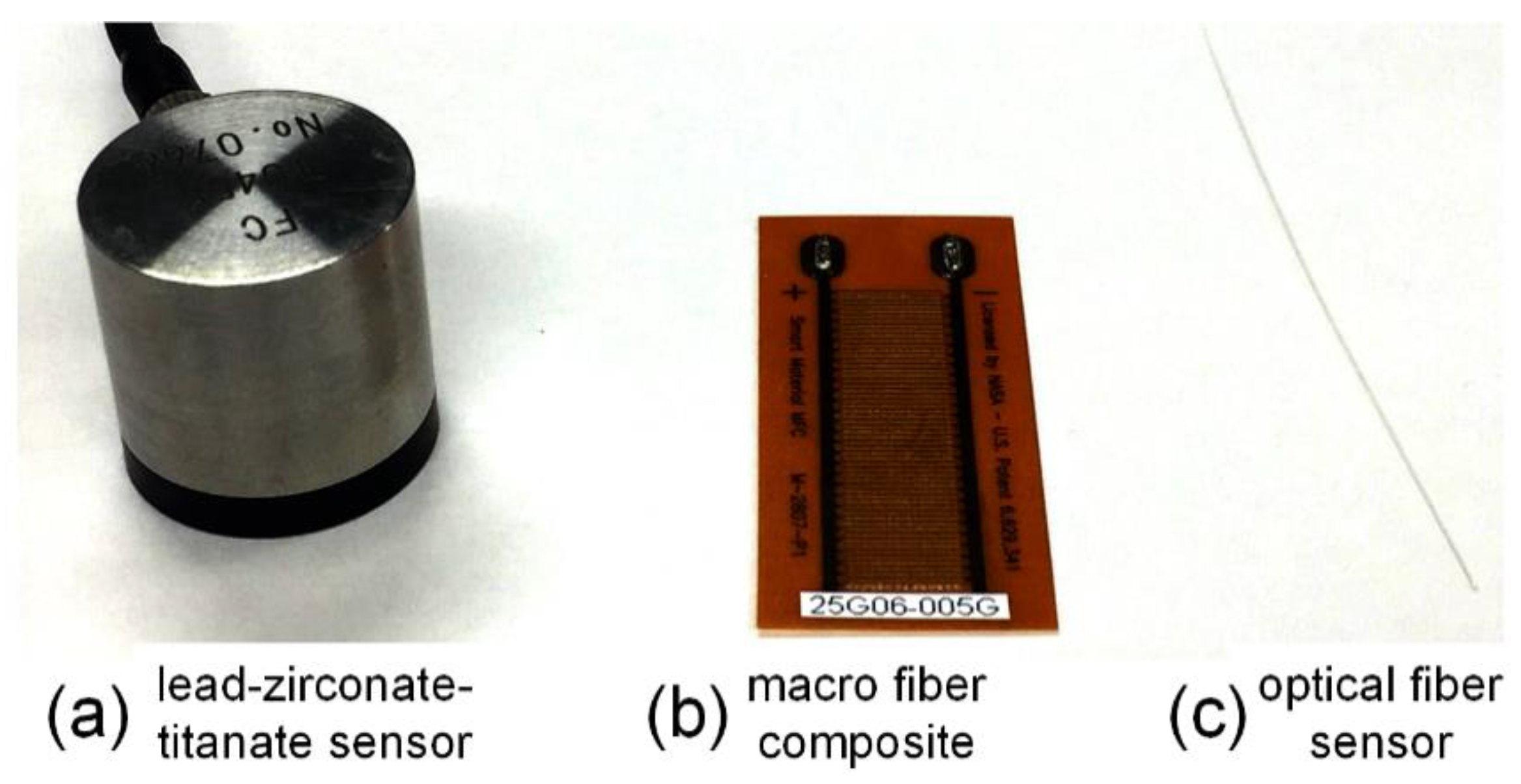

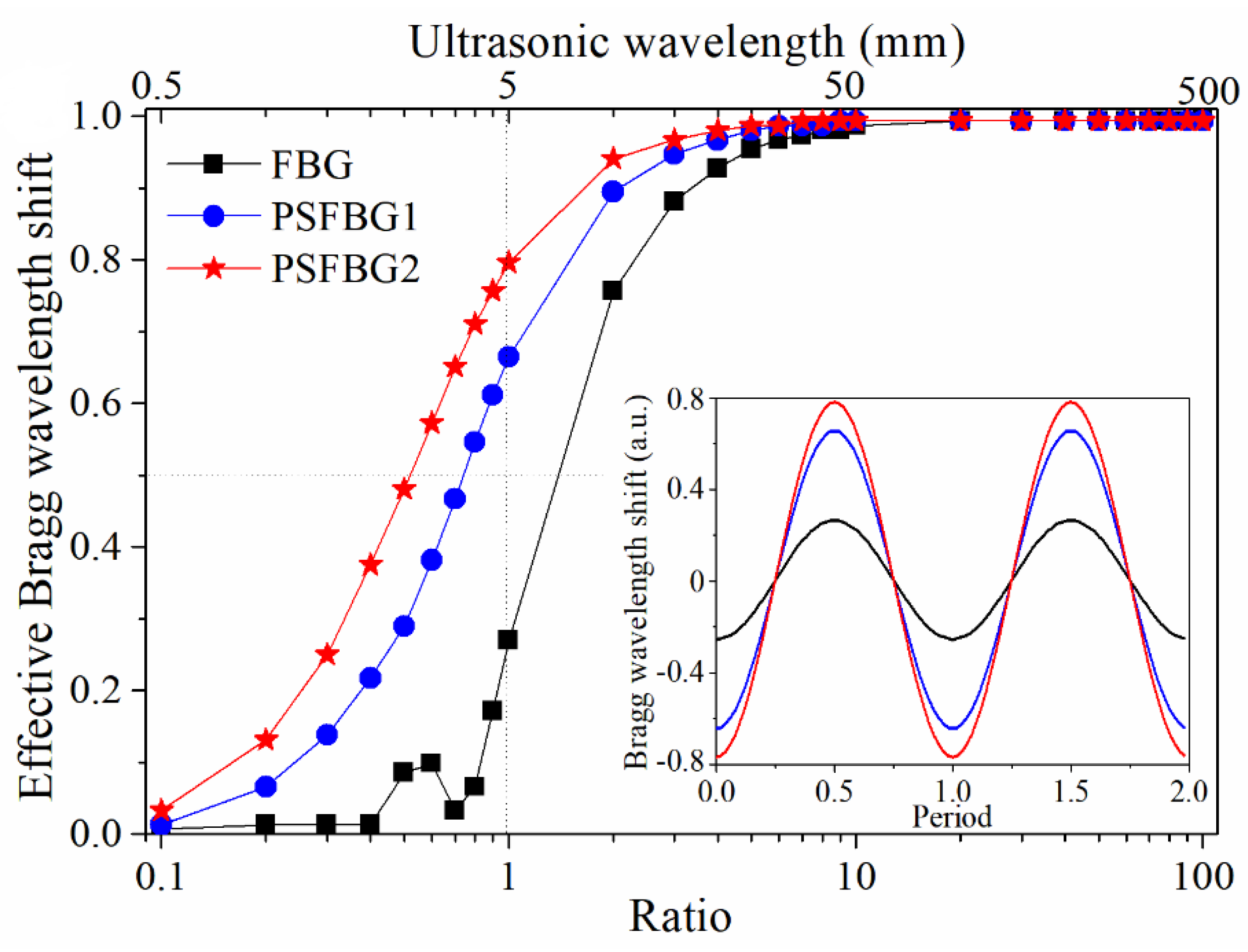


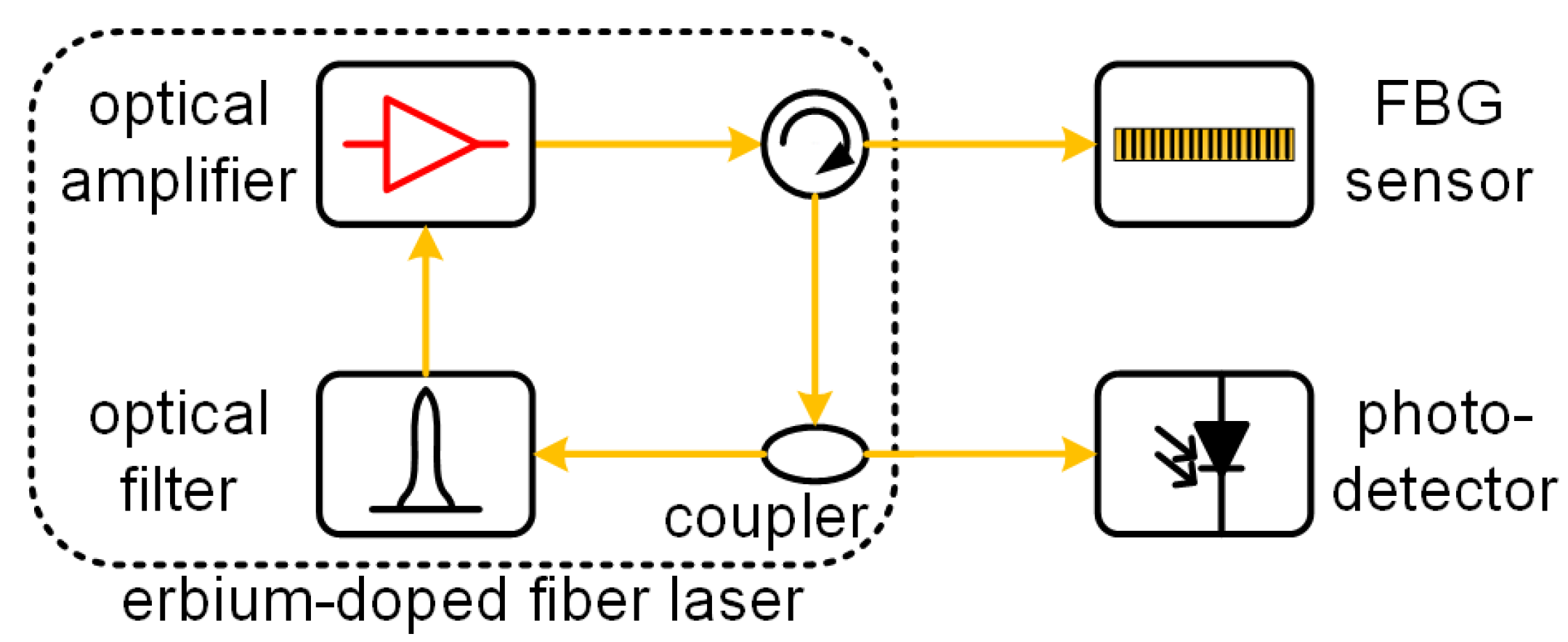

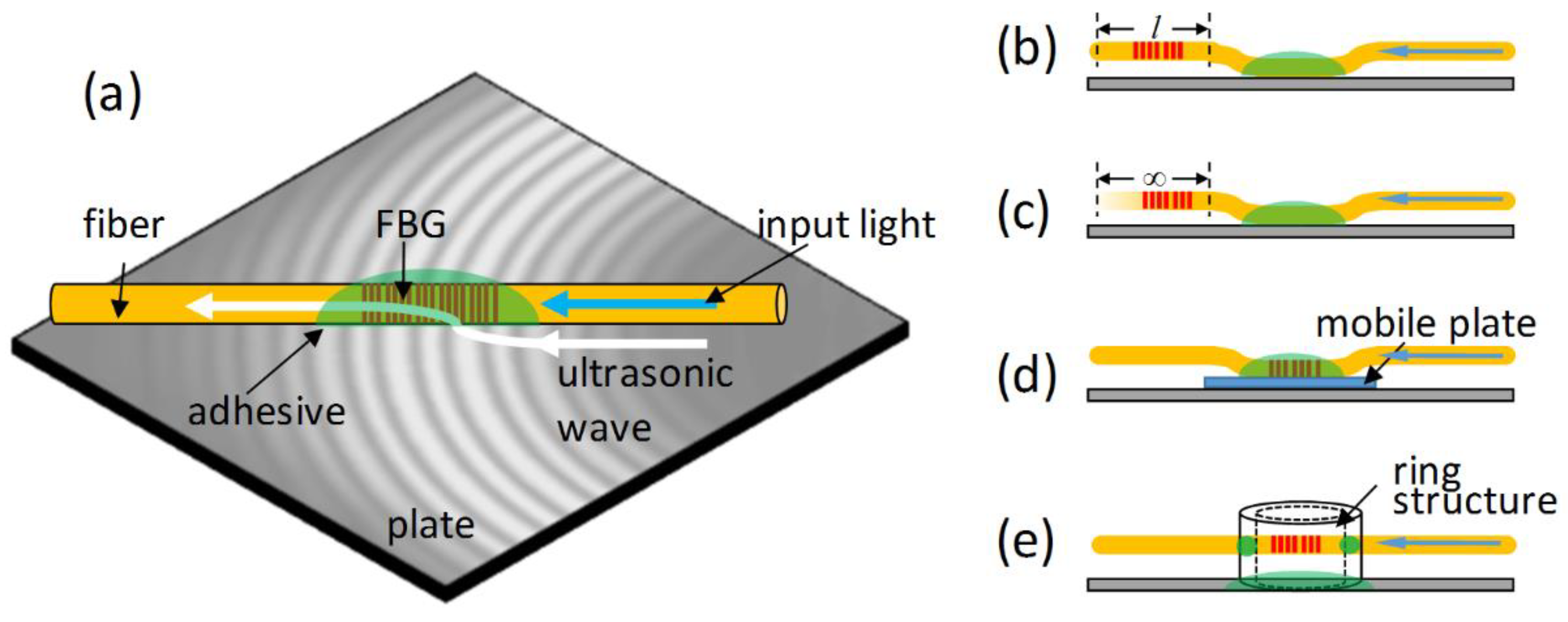

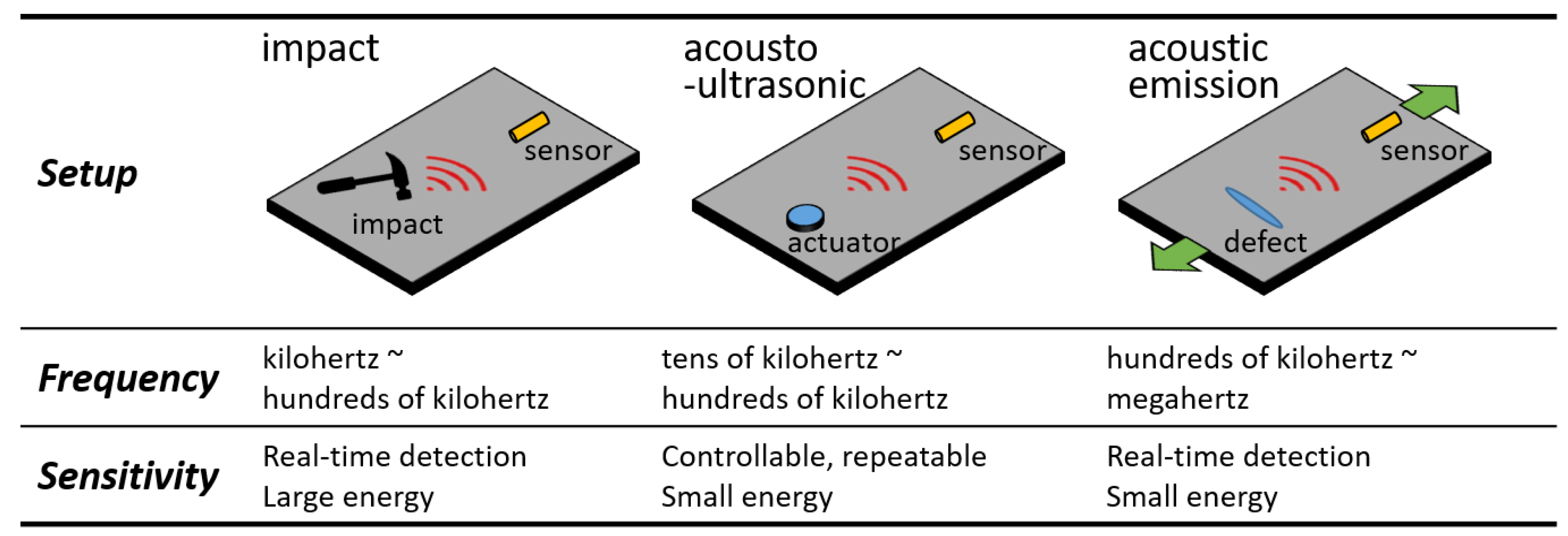
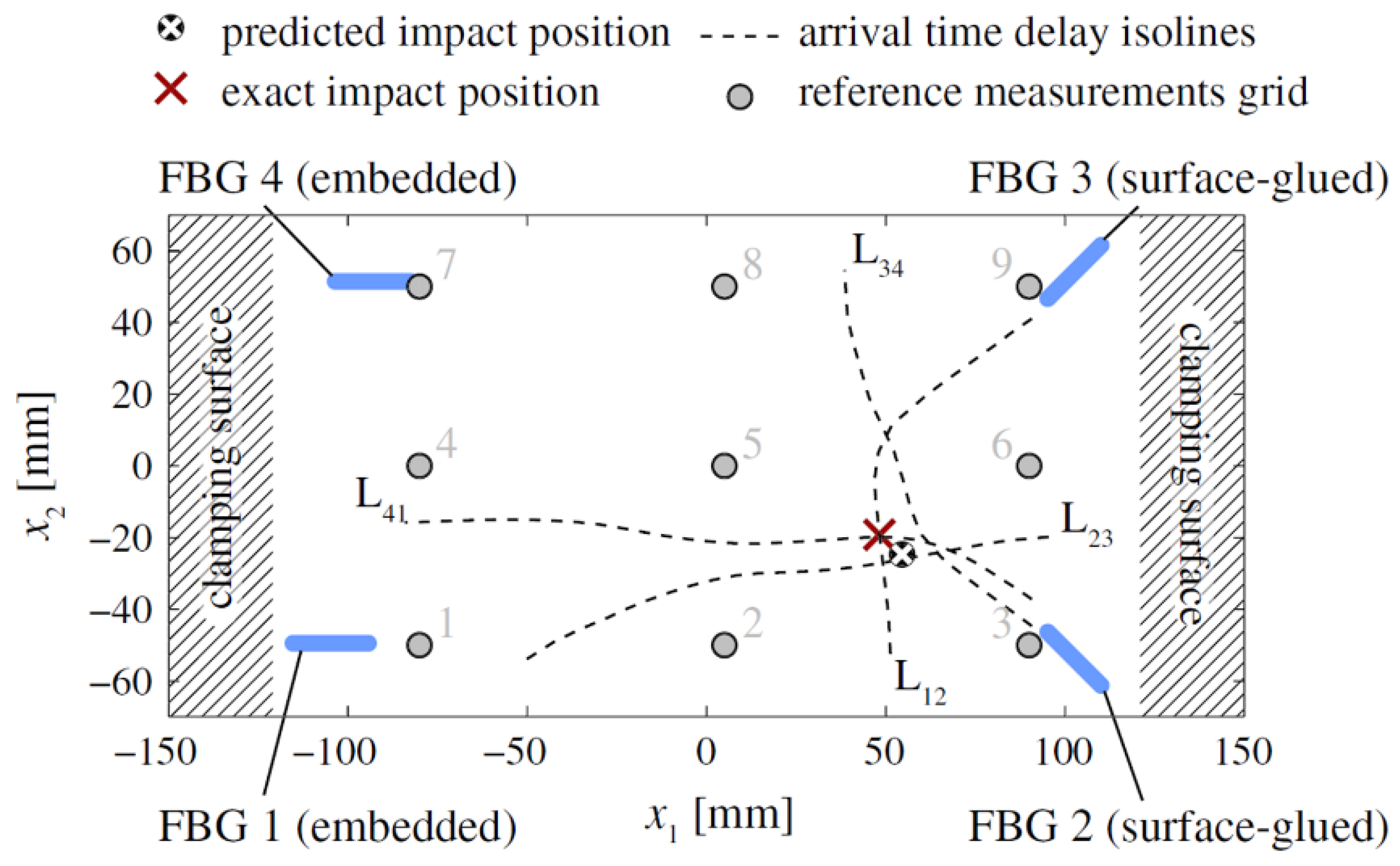
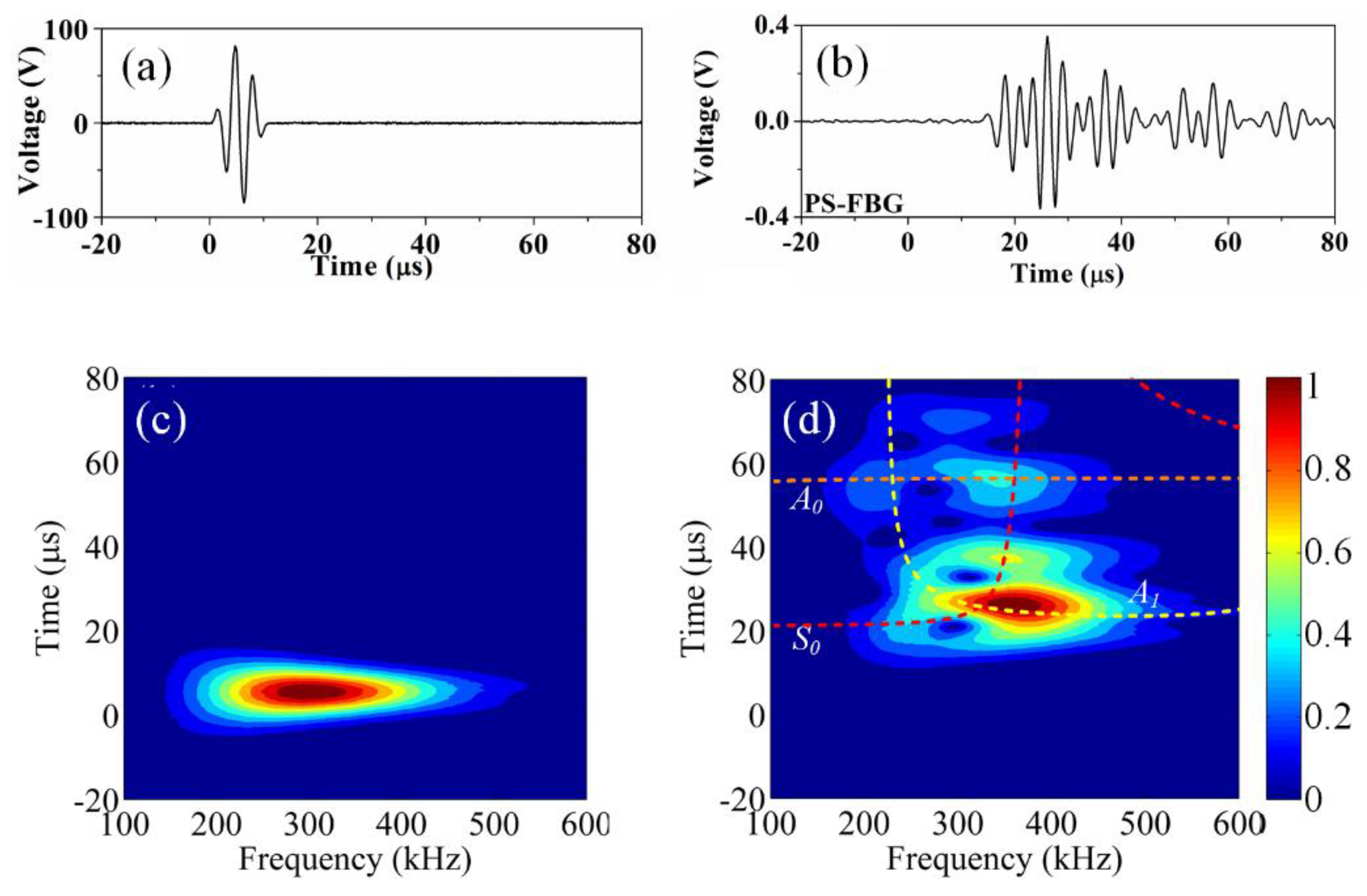
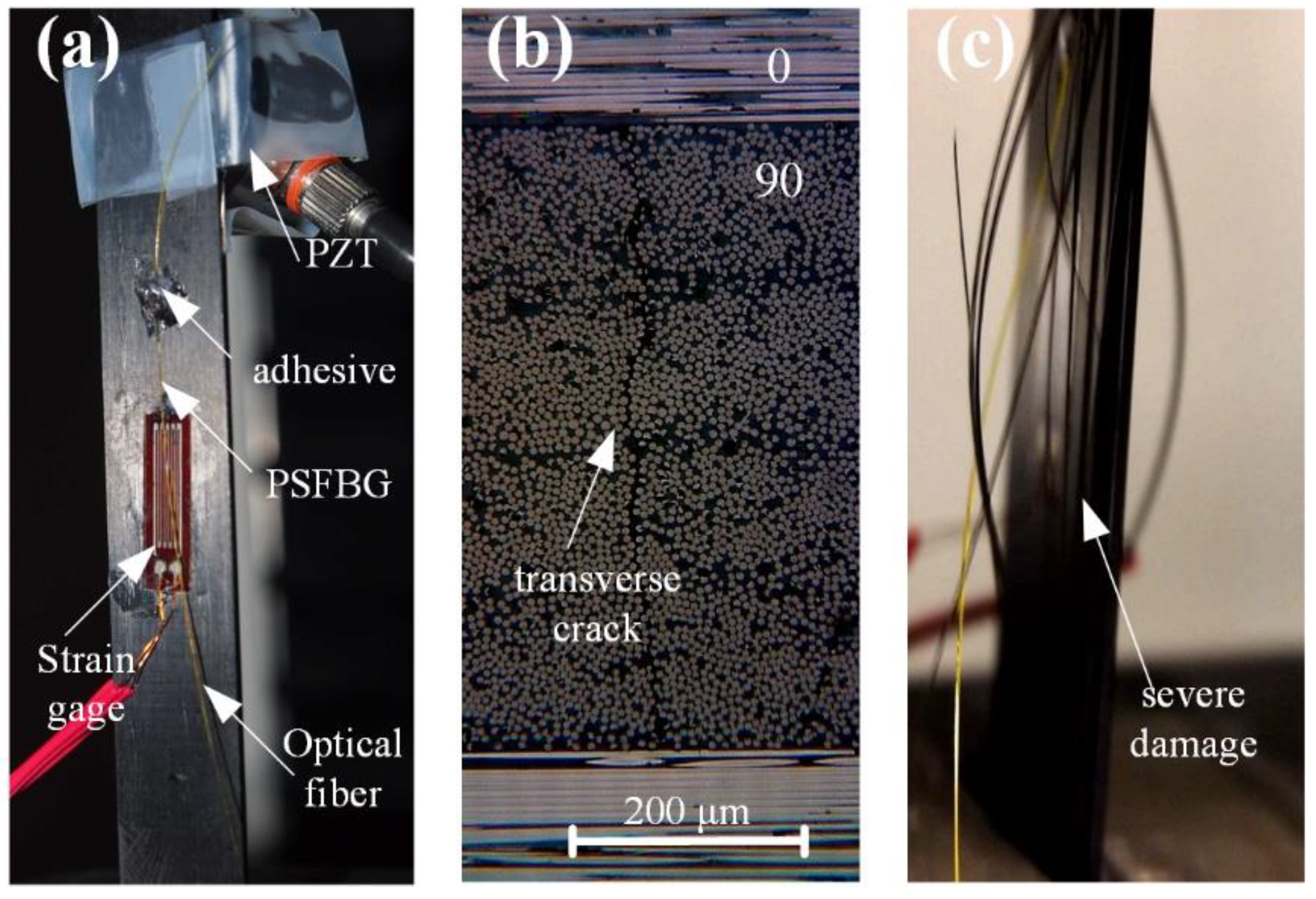
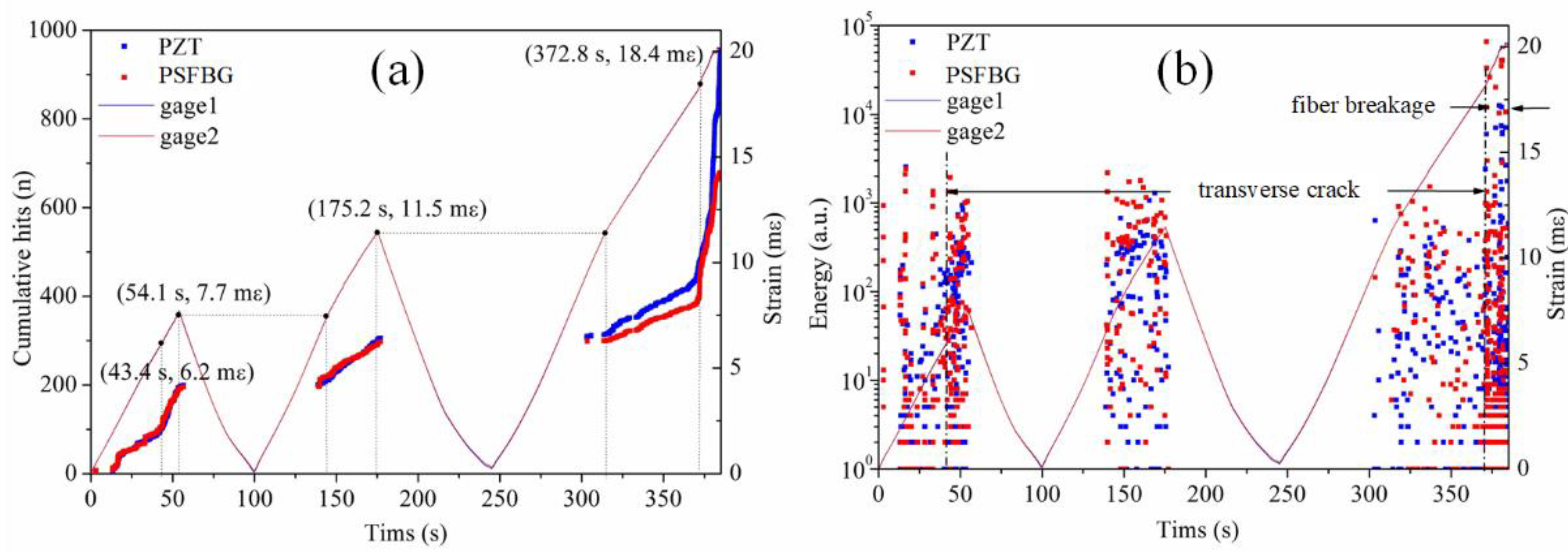
| Manufacturer | Model | Frequency Property (kHz) | Resolution Property | Wavelength Accuracy | Application |
|---|---|---|---|---|---|
| Ibsen Photonics A/S | I-MON 256 HS | 35 (Measurement frequency) | <0.5 pm | 5 pm | impact |
| Smartfibres Inc. | SmartScan | 25 (Scan Frequency) | <5 pm | impact | |
| Redondo Optics, Inc. | FBG-TransceiverTM-500 | 20 (Sampling rate) | 5 pm | 5 pm | impact |
| FAESenseTM | 300 (AE frequency) | 0.1 με/Hz | ultrasonic | ||
| Intelligent Fiber Optic Systems Corporation | I*Sense® HS48M | maximal 5000 (detection speed) | 0.1 pm | 2 pm | ultrasonic |
| Method | Light Source | Stage | Main Characteristics |
|---|---|---|---|
| 1 | Broadband light source | In practice | Fair sensitivity, multiplexing, low cost |
| 2 | Laser light source | In practice | High sensitivity, weak multiplexing, need feedback controller |
| 3 | EDFL | In laboratory | Temperature and strain resistance, frequency-dependent sensitivity, weak multiplexing |
| 4 | Modulated laser | In laboratory | High sensitivity, temperature and strain resistance, high cost, no multiplexing possibility |
| Application | Sensor | Demodulation | Installation | Reference | ||||||
|---|---|---|---|---|---|---|---|---|---|---|
| FBG | PSFBG | Broadband Light | Laser Light | EDFL | Modulated Laser | Surface Mounted | Ultrasonic Waveguide | Mechanical Assist | ||
| Impact | X | X | X | 44, 45, 84, 107, 112 | ||||||
| X | X | X | 105, 111, 139 | |||||||
| X | X | X | 28 | |||||||
| Acousto- ultrasonic | X | X | X | 27, 49, 50, 87, 115, 117–120, 122 | ||||||
| X | X | X | 25, 29, 36, 42, 80, 86, 97, 114, 117, 121 | |||||||
| X | X | X | 36, 92, 93, 97, 98 | |||||||
| X | X | X | 28, 36, 88, 101 | |||||||
| X | X | X | 63-66 | |||||||
| X | X | X | 40, 52 | |||||||
| X | X | X | 57, 58, 60 | |||||||
| X | X | X | 67, 69 | |||||||
| X | X | X | 73, 74 | |||||||
| Acoustic emission | X | X | X | 46, 125 | ||||||
| X | X | X | 127 | |||||||
| X | X | X | 96, 99, 128–133 | |||||||
© 2018 by the authors. Licensee MDPI, Basel, Switzerland. This article is an open access article distributed under the terms and conditions of the Creative Commons Attribution (CC BY) license (http://creativecommons.org/licenses/by/4.0/).
Share and Cite
Wu, Q.; Okabe, Y.; Yu, F. Ultrasonic Structural Health Monitoring Using Fiber Bragg Grating. Sensors 2018, 18, 3395. https://doi.org/10.3390/s18103395
Wu Q, Okabe Y, Yu F. Ultrasonic Structural Health Monitoring Using Fiber Bragg Grating. Sensors. 2018; 18(10):3395. https://doi.org/10.3390/s18103395
Chicago/Turabian StyleWu, Qi, Yoji Okabe, and Fengming Yu. 2018. "Ultrasonic Structural Health Monitoring Using Fiber Bragg Grating" Sensors 18, no. 10: 3395. https://doi.org/10.3390/s18103395
APA StyleWu, Q., Okabe, Y., & Yu, F. (2018). Ultrasonic Structural Health Monitoring Using Fiber Bragg Grating. Sensors, 18(10), 3395. https://doi.org/10.3390/s18103395






